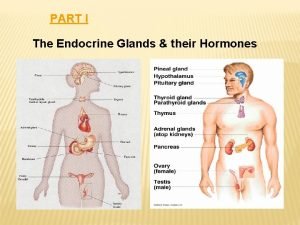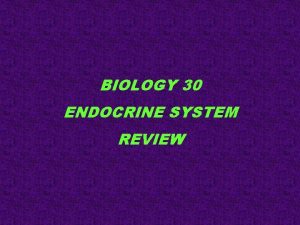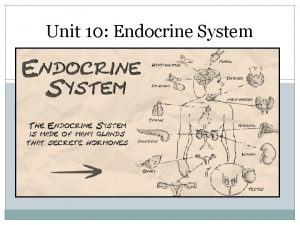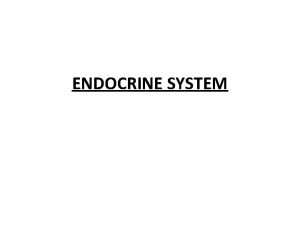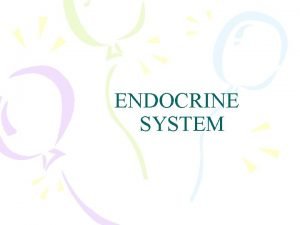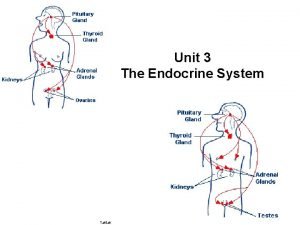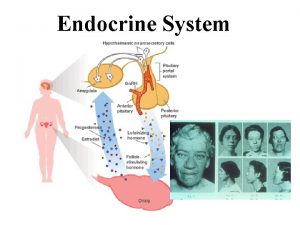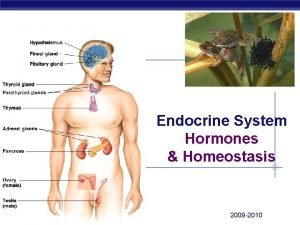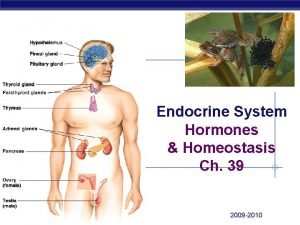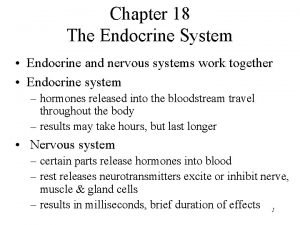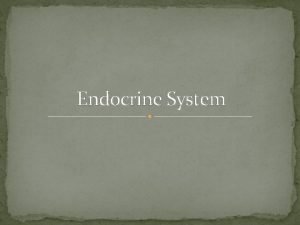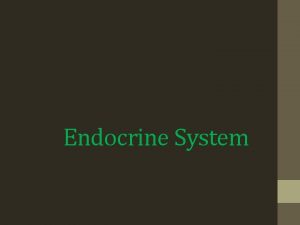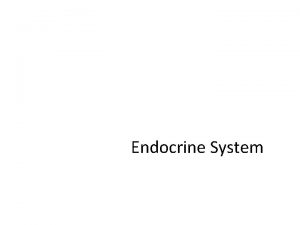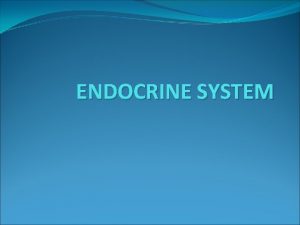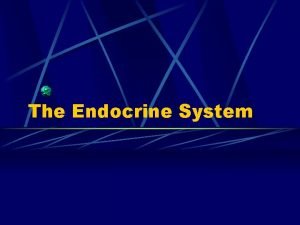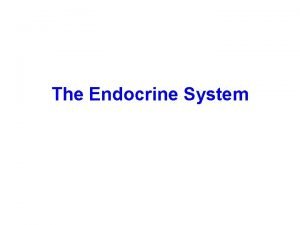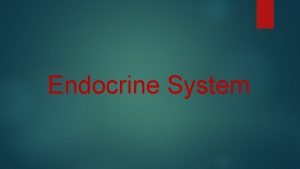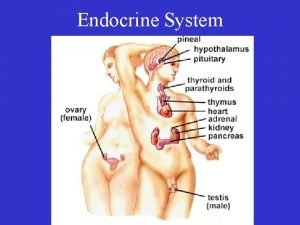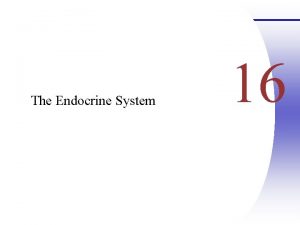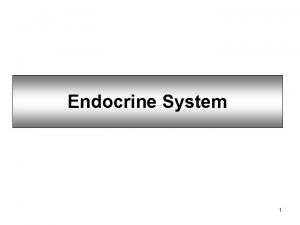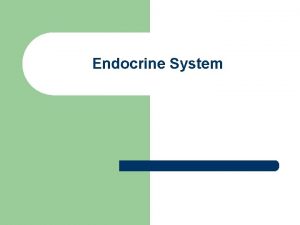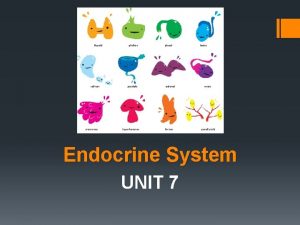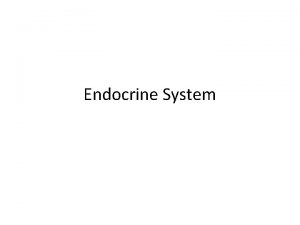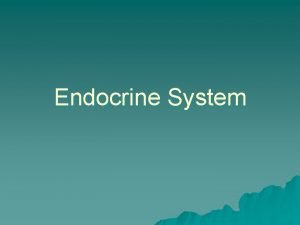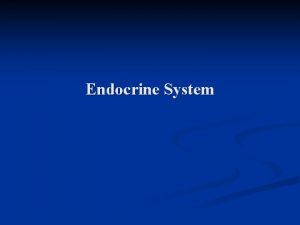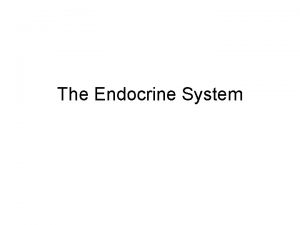Endocrine System Endocrine System Although we rarely think


























































- Slides: 58

Endocrine System

Endocrine System • Although we rarely think about them, the glands of the endocrine system and the hormones they release influence almost every cell, organ, and function of our bodies. • The endocrine system is instrumental in regulating mood, growth and development, tissue function, and metabolism, as well as sexual function and reproductive processes.

Endocrine System • Te endocrine system is in charge of body processes that happen slowly, such as cell growth • Endocrine glands usually not connected – Considered a “system” because of functional similarity

Endocrine system • The foundations of the endocrine system are the hormones and glands. • As the body's chemical messengers, hormones transfer information and instructions from one set of cells to another. • Although many different hormones circulate throughout the bloodstream, each one affects only the cells that are genetically programmed to receive and respond to its message.

• The major glands that make up the human endocrine system are the hypothalamus, pituitary, thyroid, parathyroids, adrenals, pineal body, and the reproductive glands, which include the ovaries and testes. • The pancreas is also part of this hormone-secreting system, even though it is also associated with the digestive system because it also produces and secretes digestive enzymes. • Although the endocrine glands are the body's main hormone producers, some non-endocrine organs — such as the brain, heart, lungs, kidneys, liver, thymus, skin, and placenta — also produce and release hormones.

What the Endocrine system does • Once a hormone is secreted, it travels from the endocrine gland through the bloodstream to target cells designed to receive its message. • Along the way to the target cells, special proteins bind to some of the hormones. The special proteins act as carriers that control the amount of hormone that is available to interact with and affect the target cells • Also, the target cells have receptors that latch onto only specific hormones, and each hormone has its own receptor, so that each hormone will communicate only with specific target cells that possess receptors for that hormone. • When the hormone reaches its target cell, it locks onto the cell's specific receptors and these hormone-receptor combinations transmit chemical instructions to the inner workings of the cell

What the Endocrine System does • When hormone levels reach a certain normal or necessary amount, further secretion is controlled by important body mechanisms to maintain that level of hormone in the blood. • This regulation of hormone secretion may involve the hormone itself or another substance in the blood related to the hormone. – For example, if the thyroid gland has secreted adequate amounts of thyroid hormones into the blood, the pituitary gland senses the normal levels of thyroid hormone in the bloodstream and adjusts its release of thyrotropin, the pituitary hormone that stimulates the thyroid gland to produce thyroid hormones

What the Endocrine system does • Another example is parathyroid hormone, which increases the level of calcium in the blood. When the blood calcium level rises, the parathyroid glands sense the change and decrease their secretion of parathyroid hormone. This turnoff process is called a negative feedback system

Negative feedback system • One of the most important features of the endocrine system is its regulation (control) by negative feedback. • This means that the glands within the endocrine system that stimulate the release of a hormone (for example, the pituitary) from another gland (for example, the thyroid) are eventually shut off, in a sense, so that too much hormone is not produced and a hormone imbalance is avoided


Endocrine System • Endocrine glands – Masses of epithelial tissue – Cells secrete into interstitial spaces, – Secretions (hormones) diffuse into blood – No ducts! • Contrast to exocrine glands

Endocrine System • “Hormone” – Chemical messenger secreted into blood and carried to “target cells” where it alters activity. • Other chemical messengers – Autocrines – Paracrines

Hormones • 3 -4 Chemical groups – Steroids – Biogenic amines – Peptides – Eicosanoids • Mostly paracrines • Leukotrienes • Prostaglandins

Hormones • Steroids – Derivatives of cholesterol – Four covalentlybonded rings – Adrenal cortex – Gonads

Hormones • Biogenic amines – Derivatives of tyrosine, an amino acid – Thyroid hormones • Thyroxine (T 4) • Triiodothyronine (T 3) – Adrenal medulla • Epinephrine • Norepinephrine – Usually neurotransmitter

Hormones • Peptides – “Chains” of amino acids • 4 – 200+ amino acids – – – Hypothalamus Pituitary (Ant. & Post. ) Islets of Langerhans Parathyroid hormone Digestive system hormones

Mechanisms of Hormone Action • Lipid-soluble steroids & thyroid hormones – Diffuse through plasma membrane – Enter nucleus – Forms “hormone-receptor complex” – H-R complex binds to chromosome to activate/inactivate gene(s)

Mechanisms of Hormone Action • Peptides & water-soluble amines – Hormone (A) binds to receptor on cell surface – Activates G- protein – Activates adenylate cyclase • Converts ATP to c. AMP – c. AMP activates protein kinases, which produce final effect.

Mechanisms of Hormone Action • Peptides & water-soluble amines – Other Hormone (B) binds to receptor on cell surface – Activates G- protein – Inhibits adenylate cyclase • Stops ATP to c. AMP – inhibits final effect of first hormone

Endocrine Glands Section 39 -1 Hypothalamus The hypothalamus makes hormones that control the pituitary gland. In addition, it makes hormones that are stored in the pituitary gland. Pituitary gland The pituitary gland produces hormones that regulate many of the other endocrine glands. Parathyroid glands These four glands release parathyroid hormone, which regulate the level of calcium in the blood. Thymus During childhood, the thymus releases thymosin, which stimulates Tcell development. Adrenal glands The adrenal glands release epinephrine and nonepinephrine, which help the body deal with stress. Pineal gland The pineal gland releases melatonin, which is involved in rhythmic activities, such as daily sleep-wake cycles. Thyroid The thyroid produces thyroxine, which regulates metabolism. Pancreas The pancreas produces insulin and glucagon, which regulate the level of glucose in the blood. Ovary The ovaries produce estrogen and progesterone. Estrogen is required for the development of secondary sex characteristics and for the development of eggs. Progesterone prepares the uterus for a fertilized egg. Testis The testes produce testosterone, which is responsible for sperm production and the development of male secondary sex characteristics

Endocrine System • Glands – release products to bloodstream directly. • Horomones – products deliver messages to body • Target cells – have specific receptors for specific hormones

Hypothalamus • A collection of specialized cells that is located in the lower central part of the brain, is the primary link between the endocrine and nervous systems. • Nerve cells in the hypothalamus control the pituitary gland by producing chemicals that either stimulate or suppress hormone secretions from the pituitary.

Hypothalamus • Part of brain and attached to pituitary • Controls pituitary secretions

Hypothalamus • It is considered the most important part of the endocrine system. It's often called the "master gland" because it makes hormones that control several other endocrine glands. • The production and secretion of pituitary hormones can be influenced by factors such as emotions and seasonal changes. • To accomplish this, the hypothalamus relays information sensed by the brain (such as environmental temperature, light exposure patterns, and feelings) to the pituitary

Pituitary Gland • The tiny pituitary gland is divided into two parts: the anterior lobe and the posterior lobe. The anterior lobe regulates the activity of the thyroid, adrenals, and reproductive glands. Among the hormones it produces are: • growth hormone, which stimulates the growth of bone and other body tissues and plays a role in the body's handling of nutrients and minerals • prolactin, which activates milk production in women who are breastfeeding • thyrotropin, which stimulates the thyroid gland to produce thyroid hormones • corticotropin, which stimulates the adrenal gland to produce certain hormones

Thyroid • The thyroid, located in the front part of the lower neck, is shaped like a bow tie or butterfly. • Produces hormones that control the rate at which cells burn fuels from food to produce energy. As the level of thyroid hormones increases in the bloodstream, so does the speed at which chemical reactions occur in the body. • Thyroid hormones also play a key role in bone growth and the development of the brain and nervous system in children. • The production and release of thyroid hormones is controlled by thyrotropin, which is secreted by the pituitary gland.

Parathyroid • Attached to the thyroid are four tiny glands that function together called the parathyroids. • They release parathyroid hormone, which regulates the level of calcium in the blood with the help of calcitonin, which is produced in the thyroid

Adrenal glands • The body has two triangular adrenal glands, one on top of each kidney. • The adrenal glands have two parts, each of which produces a set of hormones and has a different function. • The outer part, the adrenal cortex, produces hormones called corticosteroids that influence or regulate salt and water balance in the body, the body's response to stress, metabolism, the immune system, and sexual development and function.

Pineal gland • The pineal body, also called the pineal gland, is located in the middle of the brain. It secretes melatonin, a hormone that may help regulate the wake-sleep cycle.

Gonads – (males) • The gonads are the main source of sex hormones. • In males, they are located in the scrotum. • Male gonads, or testes, secrete hormones called androgens, the most important of which is testosterone. • These hormones regulate body changes associated with sexual development, including enlargement of the penis, the growth spurt that occurs during puberty, and the appearance of other male secondary sex characteristics such as deepening of the voice, growth of facial and pubic hair, and the increase in muscle growth and strength. • Working with hormones from the pituitary gland, testosterone also supports the production of sperm by the testes

Gonads – (females) • The female gonads, the ovaries, are located in the pelvis. • They produce eggs and secrete the female hormones estrogen and progesterone. • Estrogen is involved in the development of female sexual features such as breast growth, the accumulation of body fat around the hips and thighs, and the growth spurt that occurs during puberty. • Both estrogen and progesterone are also involved in pregnancy and the regulation of the menstrual cycle

Pancreas • The pancreas produces (in addition to others) two important hormones, insulin and glucagon. • They work together to maintain a steady level of glucose, or sugar, in the blood and to keep the body supplied with fuel to produce and maintain stores of energy

Problems with the Endocrine system • Too much or too little of any hormone can be harmful to the body. For example, if the pituitary gland produces too much growth hormone, a child may grow excessively tall. If it produces too little, a child may be abnormally short

Problems with the Endocrine system • Controlling the production of or replacing specific hormones can treat many endocrine disorders in children and adolescents, some of which include: – Adrenal insufficiency. This condition is characterized by decreased function of the adrenal cortex and the consequent underproduction of adrenal corticosteroid hormones. The symptoms of adrenal insufficiency may include weakness, fatigue, abdominal pain, nausea, dehydration, and skin changes. Doctors treat adrenal insufficiency by giving replacement corticosteroid hormones

• Cushing syndrome. Excessive amounts of glucocorticoid hormones in the body can lead to Cushing syndrome. • In children, it most often results when a child takes large doses of synthetic corticosteroid drugs (such as prednisone) to treat autoimmune diseases such as lupus. • If the condition is due to a tumor in the pituitary gland that produces excessive amounts of corticotropin and stimulates the adrenals to overproduce corticosteroids, it's known as Cushing disease. • Symptoms may take years to develop and include obesity, growth failure, muscle weakness, easy bruising of the skin, acne, high blood pressure, and psychological changes. Depending on the specific cause, doctors may treat this condition with surgery, radiation therapy, chemotherapy, or drugs that block the production of hormones.

• Type 1 diabetes. When the pancreas fails to produce enough insulin, type 1 diabetes (previously known as juvenile diabetes) occurs. • In children and teens, the condition is usually an autoimmune disorder in which specific immune system cells and antibodies produced by the immune system attack and destroy the cells of the pancreas that produce insulin. • The disease can cause long-term complications including kidney problems, nerve damage, blindness, and early coronary heart disease and stroke. To control their blood sugar levels and reduce the risk of developing diabetes complications, kids with this condition need regular injections of insulin. • Type 2 diabetes. Unlike type 1 diabetes, in which the body can't produce normal amounts of insulin, in type 2 diabetes the body is unable to respond to insulin normally. • Children and teens with the condition tend to be overweight, and it is believed that excess body fat plays a role in the insulin resistance that characterizes the disease. In fact, the rising prevalence of this type of diabetes in kids has paralleled the dramatically increasing rates of obesity among kids in recent years. • The symptoms and possible complications of type 2 diabetes are basically the same as those of type 1. Some kids and teens can control their blood sugar level with dietary changes, exercise, and oral medications, but many will need to take insulin injections like patients with type 1 diabetes

Growth Hormone Problems • Too much growth hormone in children who are still growing will make their bones and other body parts grow excessively, resulting in gigantism. • This rare condition is usually caused by a pituitary tumor and can be treated by removing the tumor. • In contrast, when the pituitary gland fails to produce adequate amounts of growth hormone, a child's growth in height is impaired. • Hypoglycemia (low blood sugar) may also occur in kids with growth hormone deficiency, particularly in infants and young children with the condition

HGH and height • Increases calcium retention, and strengthens and increases the mineralization of bone • Increases muscle mass through sarcomere hyperplasia • Promotes lipolysis • Increases protein synthesis • Stimulates the growth of all internal organs excluding the brain • Plays a role in fuel homeostasis • Reduces liver uptake of glucose • Promotes gluconeogenesis in the liver[26] • Contributes to the maintenance and function of pancreatic islets • Stimulates the immune system

Abnormal thyroid levels in blood • Hyperthyroidism. is a condition in which the levels of thyroid hormones in the blood are excessively high. • In kids the condition is usually caused by Graves' disease, an autoimmune disorder in which specific antibodies produced by the immune system stimulate thyroid gland to become overactive. • The disease may be controlled with medications or by removal or destruction of the thyroid gland through surgery or radiation treatments. • Hypothyroidism. is a condition in which the levels of thyroid hormones in the blood are abnormally low. • Hashimoto's thyroiditis, which results from an autoimmune process that damages the thyroid and blocks thyroid hormone production, is the most common cause of hypothyroidism in kids. • Infants can also be born with an absent or underdeveloped thyroid gland, resulting in hypothyroidism. It can be treated with oral thyroid hormone replacement

What other factors can effect our Endocrine system?


Biotechnology • Genetic engineering is the use of technology to alter the genomes of organisms. – Biotechnology includes genetic engineering and other techniques to make use of natural biological systems to achieve an end desired by humans. 42

Biotechnology Products Effects and Uses Anticoagulants Involved in dissolving blood clots; used to treat heart attack patients Colony-stimulating factors Stimulate white blood cell production, used to treat infections and immune system deficiencies (e. g. ; lupus) Growth factors Stimulate differentiation and growth of various cell types; used to aid wound healing (e. g. ; burn victims) Human Growth Hormone (HGH) Used to treat dwarfism Insulin Involved in controlling blood sugar levels; used in treating diabetes Interferons Disrupt the reproduction of viruses; used to treat some cancers Interleukins Activate and stimulate white blood cells; used to treat wounds, HIV infections, cancer, immune 43 deficiencies

Biotechnology Products • New prostate cancer vaccine (FDA app. Apr 2010) • Treats patients advanced form of prostate cancer. – Provenge : The series of three shots using a patient's own cells, and are designed to train the immune system to recognize and kill malignant cells. • Does NOT cure cancer, just make patients live longer (avg: 4 months) • $50 -75 K price range • Still in testing stage

Biotechnology Products • Transgenic Bacteria. – Insulin. – Human Growth Hormone. • Transgenic Plants. – Pest resistance. • Higher yields. 45

Genetic Engineering of Farm Animals • Transgenic Animals. – The use of transgenic farm animals to produce pharmaceuticals is currently being pursued. • Cloning transgenic animals. – Dolly (1997). 46

Genetic Engineering of Farm Animals • Production of bovine somatotropin (BST) 1994 – Became commercially available for dairy farmers to increase animals’ milk production – More money – Although BST is functional, harmless, and sanctioned by the FDA, much controversy exists over whether it is actually desirable. 47

Genetic Engineering of Crop Plants • Manipulation of the genes of crop plants to make them more resistant to disease from insects and improve crop yield. – Cotton: • Over 40% of the chemical insecticides used for these crops • Bacillus thuringiensis (Bt) • Harmful to caterpillars/tomato hornworms but not harmful to humans • 81% of U. S acreage is Bt cotton

Genetic Engineering of Crop Plants • About 80% of processed foods in the U. S. grocery shelves have genetically modified ingredients. calcium propionate sodium nitrite sulfites (sulfur dioxide, sodium bisulfite, potassium sulfite, etc. ) disodium EDTA, BHA and BHT High fructose corn syrup Aspertain/sucrlose

Fish Industry in the News (recent) • Genetic Eng. Salmon • Aqua. Bounty's Atlantic salmon contain a growth gene implanted from another variety of salmon that's activated by DNA from an eel-like creature called the ocean pout. • The altered fish can grow to "market weight" of as much as 13 pounds in two or three years, compared with three to four years required for natural salmon • Females are sterile

Other industries… • Fish: (ex: wild salmon) are given color (dye) pellets to eat to give them the “wild” color of real wild salmon • Beef: most meats produced by conventional methods are high in saturated fat because the animals are fed massive levels of hormones and grains made out of cattle corn in order to fatten them up quicker than normal. This can cause high cholesterol and other health problems like heart disease and obesity ¡ Plus the antibiotics and steroids they use on ALL animals

Other industries… • Chicken: • • The Food and Drug Administration (FDA) is responsible for ensuring that animal drugs and medicated feeds are safe and effective for animals, and that food from treated animals is safe for humans to eat. Steroid hormones are used in cattle but not in poultry. Residue levels of these hormones in food have been demonstrated to be safe There is no “number” of how many antibiotics are given to chickens The FDA and CDC have recommended guidance the importance of over use of the antibiotics in the food supply But some scientist argue that they are being overused Hormones used in poultry is illegal now in the US – Only NATURAL occurring hormones are accepted

Chicken • Antibiotic Resistance – Consumer reports 1/2010 looked at different drugs that had resistance by bacteria • • Tetracycline Amoxicillin Ampicillin Ciprofloxacin

National Chicken Council Statement • “No scientific study has even shown that a treatment failure in humans as resulted from the use of antibiotics in chicken. Statements about the amount of antibiotics used in poultry production are greatly exaggerated…chicken is safe. ” • “Any bacteria that may be on chicken are easily killed by the heat of normal cooking. ”

Is eating genetically modified food dangerous for your endocrine system? • EPA, FDA, and USDA approve food regulations in the U. S. • EPA approved EPSP enzyme (change in protein sequence) for human consumption • Bt (inhibits pests on cotton/corn crops) protein is approved for human consumption by the EPA

Benefits vs Risk • Benefits: – Increased pest and disease resistance – Drought tolerance – Increased food supply – Farmers make more money and keep food cost down for consumers

Benefits vs Risk • Risk: – Introducing allergens and toxins in foods – Antibiotic resistance – Adversely changing the nutrient content of a crop – Creation of “super” weeds and other environmental risk – Unknown long-term health effects

So, do you think that it is safe to eat genetically modified foods? • This is for you to decide…
 Mukesh ambani signature
Mukesh ambani signature Endocrine system and reproductive system
Endocrine system and reproductive system Endocrine system and nervous system
Endocrine system and nervous system Lymphatic system vs endocrine system
Lymphatic system vs endocrine system Endocrine vs nervous system venn diagram
Endocrine vs nervous system venn diagram Endocrine system and nervous system
Endocrine system and nervous system Robin and jay poem
Robin and jay poem Think fam think
Think fam think Things a computer scientist rarely talks about
Things a computer scientist rarely talks about Sarah rarely misses her basketball shots
Sarah rarely misses her basketball shots Often usually sometimes
Often usually sometimes Why is canada rarely impacted by natural weather hazards
Why is canada rarely impacted by natural weather hazards Classification of gypsum products
Classification of gypsum products Why do nonmetals rarely lose electrons
Why do nonmetals rarely lose electrons Contradiction
Contradiction Chapter 16 matching question 6-10
Chapter 16 matching question 6-10 Parts of the endocrine system
Parts of the endocrine system Module 10 the nervous and endocrine systems
Module 10 the nervous and endocrine systems Comparison of endocrine and nervous system
Comparison of endocrine and nervous system Gonads glands
Gonads glands Endocrine system fact
Endocrine system fact External anatomy of a rat
External anatomy of a rat Chapter 45 hormones and the endocrine system
Chapter 45 hormones and the endocrine system Pearson
Pearson Exocrine glands are ductless
Exocrine glands are ductless Chapter 7:13 endocrine system
Chapter 7:13 endocrine system Stimulus endocrine system
Stimulus endocrine system Stimulus humoral
Stimulus humoral Endocrine glands
Endocrine glands Biology 30 endocrine system
Biology 30 endocrine system Chromaffin cells
Chromaffin cells Pituitary
Pituitary Endocrine system analogy
Endocrine system analogy Endocrine system introduction
Endocrine system introduction Endocrine system abbreviations
Endocrine system abbreviations Endocrine system
Endocrine system Endocrine system
Endocrine system Endocrine system
Endocrine system Pancreas in endocrine system
Pancreas in endocrine system Endocrine glands
Endocrine glands Endocrine system
Endocrine system Chapter 16 lesson 1 the endocrine system
Chapter 16 lesson 1 the endocrine system Endocrine system regents questions
Endocrine system regents questions Endocrine system regents questions
Endocrine system regents questions Nontropic hormones
Nontropic hormones Endocrine tissues
Endocrine tissues Lipid soluble hormones examples
Lipid soluble hormones examples That although thesis
That although thesis Five conjunctions
Five conjunctions The moon is faithful although blind
The moon is faithful although blind Although in the middle of the sentence
Although in the middle of the sentence Despite although
Despite although Bart complied with his friends
Bart complied with his friends Use although in a sentence
Use although in a sentence Even though i walk through the valley
Even though i walk through the valley Difference although even though
Difference although even though Similarities and contrast
Similarities and contrast Although statement
Although statement However and commas
However and commas
















